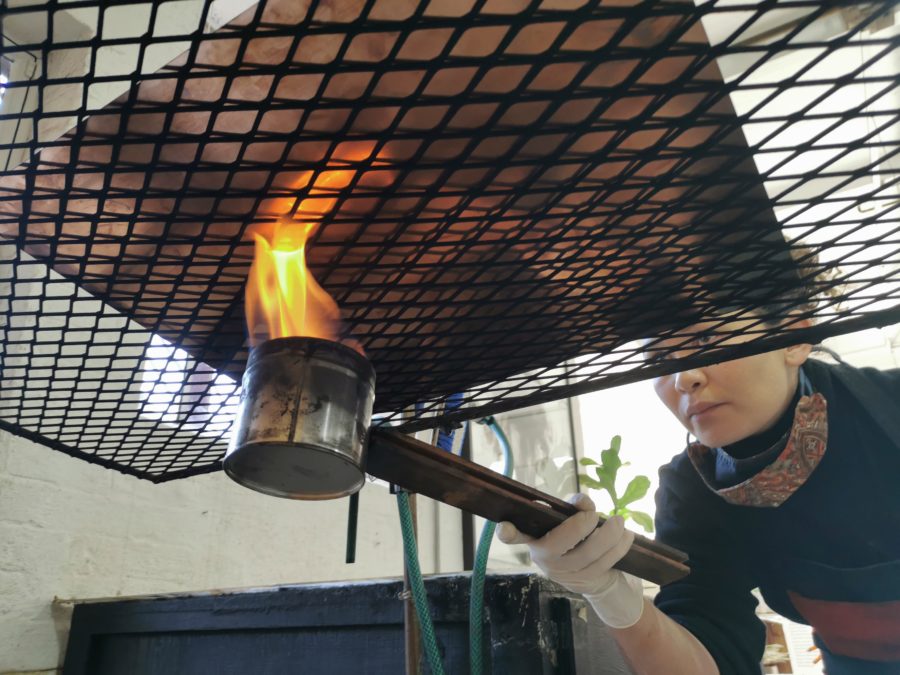Written by Boemo Diale
My first day in the project space was spent mostly observing and watching. The space itself is bright, colourful and wonderfully organised making for any creative to be inspired in ways one could improve their own studio. In every corner sat something seemly curated in its place. A shelf of inks galore or scissors hung playfully on hooks. Each member of the team concentrated in their task was inspiring for a young artist.

Boemo in the David Krut Workshop at Arts on Main. Left: Printer Sbongiseni Khulu. Middle: Artist Stephen Hobbs. Right: Boemo Diale at the press wheel.
My main objective for starting my internship was to explore how print making mediums could inform my own personal practice. Generally my practice is an intuitive process toying with paints, pastels and cut outs but I was seeking to find ways to incorporate more sophisticated techniques to strengthen my work. I observed artist in residence Stephen Hobbs whose work was especially conceptual which helped me to question ways I could further mature my practice. Sbongeseni walked me through the process of basic printing fundamentals such as setting a press to the correct pressure depending on what you were printing, the speed at which one should turn the press, wetting and blotting papers, inking up plates and registration of plates and paper on the press. These were some of the initial methods I was introduced to. I was especially inspired by printmaking because of this need to plan, set out and work according to steps before seeing the result. This delayed gratification made the artwork itself so much more meaningful.


My other objective was to find ways to bridge my artistic practice with my studies in Film and Television. My introduction to monotypes by Roxy sent a light bulb to my head. A monotype is made by transferring an image from a matrix (perspex lined with gum arabic to keep either oil or water colour sticking to the matrix) to a damp sheet of paper to make your work. Nina was huge help in encouraging me not to overthink it. I began thinking how well monotypes would work when storyboarding or scene setting. They’re quick, simple and easy to layer. My favourite was specifically water colour monotypes.
During the end of my internship I was privileged enough to observe Jilian Ross and William Kentridge work on their project. The workshop was buzzing with energy in preparation and I learnt of polishing copper plates (a tedious and exhausting job with a satisfying result) and gluing paper. Roxy and Sarah also exposed me to how household and industrial materials can be useful in the workshop such as copper, solvents in the salt bath and polishing materials. Kim showed me how plates are steel faced and prepped before printing. The process is quick and surprisingly included numbers. Kim introduced me to chine colle, the subtle use of paper cutouts to change colour in prints that make a huge difference. Further informing my collaboration of film and art I was exposed to some of Kentridge’s processes of snapshotting fragments from his films and plays to create works. Some of the more mundane tasks like removing staples from staple belts made for time to reflective upon work. In this time I was exposed to artists like Natalie Paneng and Peter Cohen who worked primarily with Lino Cuts. Sbongiseni, potentially a Lino cutting genius showed me mark making techniques to add dimension to Lino cuts I otherwise would not have known possible.

DKW Printer Kim-Lee Loggenberg heating up a copper plate. This is part of the process to prepare a plate to be etched.
I’m immensely grateful for the time the team has taken to introduce me to these elements of printmaking as someone who has not had experience with it before. I’m thankful for the days I spent giggling with Siphiwe and Clementine as I worked through these new tasks. I’m immensely inspired by the team who are so dedicated to their craft and it’s outcome. My last moment in the space I was privileged enough to independently try my hand at carving and printing a Lino. Excitingly I incorporated symbols and motives from my personal practice and carved a movable Lino, an edition of 5 each unique in their own right. Sarah and Roxy suggested I make a stop motion animation with each piece which delighted my use of editing in film.



5 editions of Boemo’s linocut, each signed by her, are available for sale!
Contact [email protected] to inquire about purchasing one of these prints.